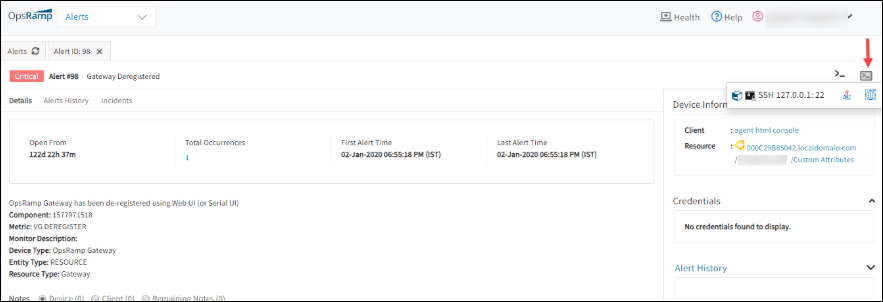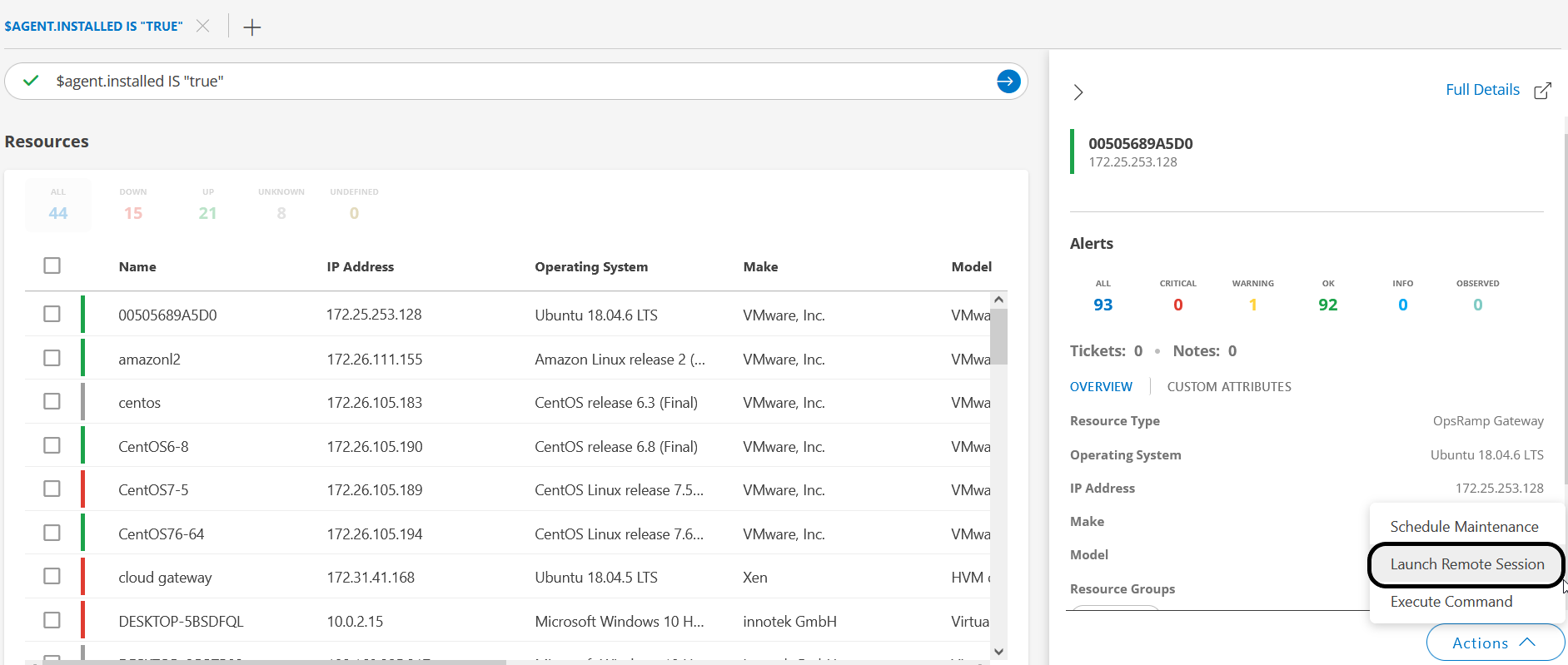A browser console permits you to access a remote server using a web browser. Browser consoles enter the following functionality:
- Playback console recording
- Clipboard access
- Shared Drive
To add or launch a browser console, enable Browser Consoles for the client. A user can configure browser console settings using the user preference setting option.
User permissions define the following user capabilities:
- A user with Consoles Manage permission can add, edit, or remove a console.
- A user with Consoles View permission can view consoles created by other users.

Note
- A green colour browser console icon indicates that a console has either been launched or is in use.
- A blue colour browser console icon indicates that a console has neither been launched nor is in use.
The colour of the console icon provides information about:
- A user signing in using an RDP/SSH through the OpsRamp remote console
- An active remote session
This information is useful during the NOC users' shared sessions.
Prerequisites
- Enable an HTML-enabled browser for launching the browser console.
- Activate the browser consoles and their related features for the client.
- Verify the whitelisted IPs. See: Public IP addresses
- Verify the inbound and outbound communication for whitelisted IPs. Communications are required for accessing remote consoles.
- Establish permissions for device manager and console manage.
- Enable the protocol on the target device, such as SSH, RDP, or Telnet.
- Validate the port numbers and confirm that the ports are available. Ports are checked for launching the remote console.
- Activated agent and gateway on the target device or on the managed device.
- Verify that the login information is available for the target device.
- Verify that the target device status is active.
When launching a console on a gateway, enter the localhost IP address: 127.0.0.1.
| Gateway Version | Agent Version | Features available |
|---|---|---|
| 7.00 | 7.00 | All features except SSH-based shared drive |
| 8.00 and above | 8.00 and above | All features |
Supported protocols
The protocols supported by the browser console are:
- RDP
- SSH
- Telnet
Supported key exchange algorithms
The browser console supports the following key exchange algorithms:
- diffie-hellman-group-exchange-sha256
- diffie-hellman-group-exchange-sha1
- diffie-hellman-group14-sha1
- diffie-hellman-group1-sha1
Add browser consoles for SSH/Telnet/RDP
Add the details of the remote device on which you want to launch a console. You can also edit or delete the configured remote console.
Go to Infrastructure.
Click the category to which the target resource belongs.
Click the required resource name.
From the resource Overview page, click the settings icon and select Add Console.
Click +Add to add a new set of console details. You can also edit the existing sample details to add a remote console. The existing sample details are configured for the agent.
Configure the following information on the consoles window:
- Connector: Element (Agent or Gateway) managing the target device.
- Protocols: Protocol that you want to use to communicate with the target device.
- Port: Port that transmits and receives data. The port numbers vary with Services.
- Username: Login username of the target device. Username is optional.
- Password: Login password of the target device.
- IP Address: IP Address of the target device.
- Name: Name of the console. You can add Name in the RDP IP address format of the target device and port number. For example,
RDP 12.171.1:3389
Click Save.
The console is added to the console list.
Click Add Consoles again from the settings icon to add more consoles or to remove existing consoles.
Launch browser consoles for RDP
Add the device information to launch a browser console.
It is recommended that you select the Network Level Authentication (NLA) option on the remote Windows device for secure communication. You must be aware of NLA settings on the target device.
- If NLA is enabled on the target device, user should select the NLA option as protocol security from console launch popup. Username, password and domain are mandatory fields.
- If NLA is disabled on the target device, user can select either NLA or TLS as protocol security from console launch popup.
Launch Secure Shell consoles
- Go to Infrastructure and select the resource name for which you want to add the console.
- Click Launch Remote Console.
- Click SSH or SSH with certificate.
- From the Launch Browser Console dialog box, provide Ticket ID/Alert ID to associate the console activity to a ticket and add Activity Log Notes.
- Select the applicable checkbox:
- Use Credentials: If credentials are available in credentials sets, select the option from the Credentials drop-down option.
- I have Credentials: If you have credentials, select the option. For SSH, enter username and password. For SSH with certificate, select Choose File to upload Certificate and enter a Pass Phrase. Private keys are required for SSH keypair-based authentication.
- Click Launch.
- Enter your credentials in the browser console.
The target remote device is now connected, enabling activities to be performed on the device.
Launch Telnet consoles
- Go to Infrastructure and click the resource name for which you want to add the console.
- Click Launch Remote Console.
- Click Telnet.
- From the Launch Browser Console dialog box, enter the Ticket ID/Alert ID to associate the console activity to a ticket and add an Activity Log Note.
- Click OK.
Disconnect browser consoles
You disconnect from the session when you are done.
- Press
<Ctrl><Alt><Shift>to display the Clipboard window. - From the username drop-down menu, click Disconnect.
The session is disconnected.
Launch consoles from different pages
In addition to launching a console from the Infrastructure page, you can also launch consoles from the following pages:
- Alert details page
- Gateway details page
- Infrastructure search page
Launch console from the alert details page
- Go to Alerts.
- Click the required alert ID. The Alert Details page displays.
- Click the consoles icon.
- Click the browser console icon to launch the console you want.

Launch console from the gateway details page
- Go to Setup > Resources > Management Profiles.
- Click the required management profile name.
- In the Management Gateway Details section, click the gateway UUID, which displays the GATEWAY DETAILS page.
- Click the Consoles icon.
- Click the browser-based console icon to launch the console.

Launch console from the Infrastructure Search page
Go to Infrastructure > Search.
In the Search field, type $. A list of attributes is displayed.
Select the required attribute and complete the search query using the attributes that are dynamically displayed below the field. Example query:
$agent.installed IS "true"Click the blue arrow mark to search for the resources. A list of resources is displayed in the Resources overview page.
Click the target resource.
In the slide-out screen that appears, click the Actions and then the Launch Remote Session button.
In the Launch Remote Session > Consoles field:- Select a console from the existing list.
- Add a new console by clicking the Add button.
You cannot delete a console from the Launch Remote Session page.
In the Credentials field:
- Select the applicable checkbox for existing credentials:
- Use Credentials
- I have Credentials
- Add new credentials by clicking the Add button.
You cannot delete credentials from the Launch Remote Session page.
Fill the mandatory fields on this page.
Click Launch. The console will be launched.
